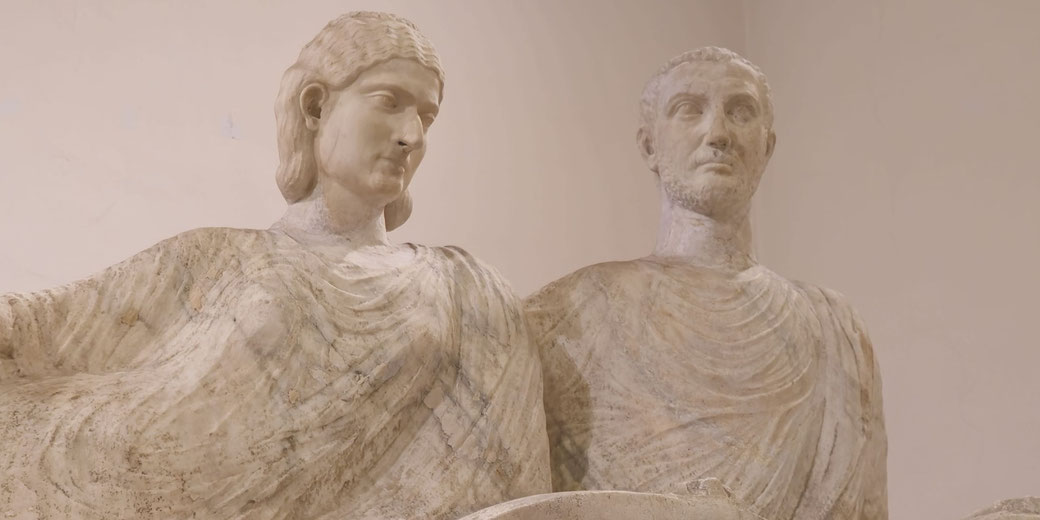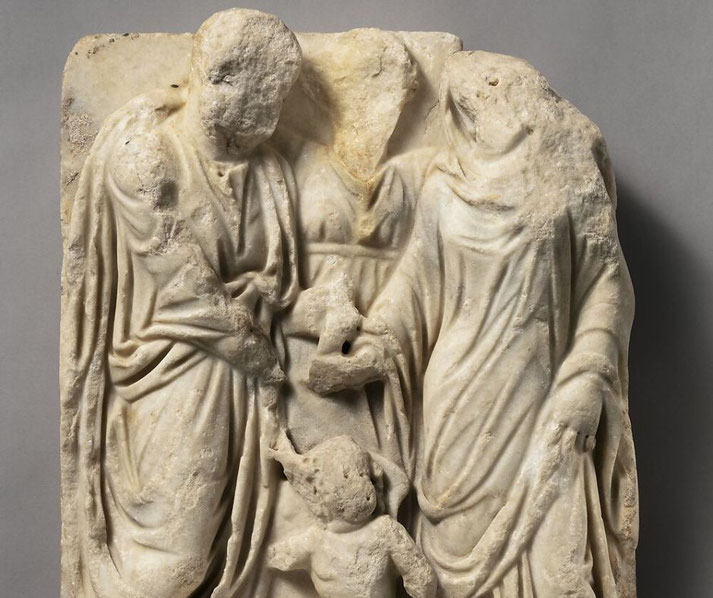Marriage in ancient Rome had very little to do with love but was much more sinister

Among Roman elites, marriage worked primarily as a legal strategy rather than as a personal choice. From the late Republic onwards, senators and nobles arranged unions to secure political alliances, control inheritance, and strengthen the power of the paterfamilias rather than to create affection.
At every level of society, women entered marriage under strict rules and limited legal protection that kept women under constant supervision, while men benefited from a system that was designed to protect their property and reputation.
The strict Roman rules around marriage
Roman law outlined two forms of marriage that defined a woman’s legal status for the rest of her life.
In a cum manu marriage, a woman left her birth family and entered the legal control of her husband or father-in-law.
She no longer inherited from her birth family and became part of her husband’s household, both legally and ritually.
In a sine manu marriage, which became increasingly common during the late Republic, the woman continued under her father’s legal control and retained the right to inherit from him.
As a result, the wife’s property often stayed outside her husband’s direct control unless explicitly transferred.
However, Roman citizens could only enter a valid marriage if both parties held the legal right to do so under the principle of conubium.
Citizens could marry one another, but certain groups faced restrictions. For instance, senators and their male descendants, who held senatorial rank, could not marry freedwomen, prostitutes, or actresses.
Soldiers on active service were officially forbidden to marry during most of the Principate, although this ban was often ignored in practice and was eventually lifted by the emperor Septimius Severus in the early third century AD.
Those without conubium who were slaves or foreigners could not enter matrimonium but might form informal unions called contubernia, which had no legal standing under Roman law and offered no inheritance rights unless freedom was later granted.
Among slaves, contubernium provided a semblance of family life that could end without any legal process.
Also, the dowry played a central role in marriage negotiations. Families treated the dos as a financial instrument that reinforced the seriousness of the agreement.
It might include land, slaves, jewellery, or silver, which could affect a woman's chances of securing a match.
Fathers offered dowries not just to provide for their daughters but to strengthen their influence with in-laws.
If the marriage ended, the return of the dowry became a source of legal dispute. In some cases, if the woman had behaved in a way that was considered immoral, the husband could withhold part or all of the dos.
Roman legal experts, including Gaius, later wrote down such rules in legal texts like the Institutes, which ensured that dowry disputes provided steady work for lawyers.

How people got married in ancient Rome
A Roman marriage relied on mutual consent and on the couple's continued residence together, since once a couple agreed to live together as husband and wife and both met the legal conditions for conubium, the marriage had legal force.
There was no need for a priest, ceremony, or official registration with the state.
Still, wealthier families conducted weddings with rituals and symbols that showed respectability and fulfilled tradition.
Before the marriage, families often arranged a sponsalia, a formal betrothal which included the exchange of gifts and the dextrarum iunctio, or joining of right hands.
This public agreement reinforced the reputations of both households. During the wedding, the bride typically wore a white tunic tied with the nodus Herculeanus, a knot associated with Hercules that was believed to protect the bride and symbolise chastity.
She also wore the flammeum, which was a bright orange veil, along with matching shoes, and her hair was styled in a traditional parting with a pointed spear.
Afterwards, the wedding procession led the bride to her new home. She was carried across the threshold, lit the hearth fire, and touched water and fire in a ceremony that initiated her into her new household.
The presence of witnesses, especially ten in number, generally helped confirm the validity of the union in the eyes of the community.
In some cases, a marriage could also be formed by usus, a type of common-law marriage that gave the husband legal authority over the wife if she remained in the home for a full year unless she was absent for three consecutive nights.
The real reason many Romans got married
At the upper levels of society, marriage primarily served to preserve bloodlines as a means to consolidate authority and to advance specific political agendas.
Roman fathers viewed daughters as assets. Through careful matchmaking, they could link their gens to another powerful family, gain influence in the Senate, or strengthen business ties.
As a result, marriage choices followed strategic goals, not personal feelings.
For example, Julius Caesar arranged the marriage of his daughter Julia to Pompey the Great in 59 BC.
This union had supported the First Triumvirate by binding the families of Caesar and Pompey together.
When Julia had died in 54 BC, likely due to complications from childbirth, the alliance collapsed, and civil war followed shortly after.
The collapse of such a marriage could have political consequences that affected more than the household.
Augustus later forced his daughter Julia the Elder into marriages with Marcus Agrippa and, after his death, Tiberius.
He used her as a pawn to secure political stability.
Augustus had turned this logic into law. His Lex Julia of 18 BC addressed adultery and public morality, while the Lex Papia Poppaea of AD 9 introduced severe penalties for childlessness and rewards for fertility.
Men and women of the senatorial and equestrian classes had to marry and produce children, or they risked losing inheritance rights.
These laws reinforced the view that marriage was a duty to the Roman state. Girls were often married in their early teens, with some as young as twelve, to men in their thirties or older in order to produce as many legal children as possible, as women had no legal say in these arrangements.
Fathers and male guardians negotiated the terms, assessed the suitability of potential husbands, and finalised agreements with financial and political interests in mind.
Once married, women were expected to produce children quickly and raise them under the authority of the paterfamilias, who retained the power of life and death over everyone in the household.
What about marriage among poorer Romans?
Among lower-class Romans, marriage rarely involved formal negotiations, written contracts, or large dowries.
Poor couples often lived together and raised families without ceremony. As long as they intended to live as husband and wife and were eligible under law, their relationship counted as matrimonium.
They could marry without gifts, witnesses, or celebration. Still, their union carried legal rights, including inheritance for children and protections for property.
Some poorer families conducted small ceremonies or simply shared a meal with friends, but many marked the occasion with nothing more than moving into a shared home.
Unlike elites, who married for influence, poor Romans often married for companionship and practical survival needs.
A stable marriage helped secure income through shared household labour and support for childcare.
It also provided legitimacy for children, which could be important for inheritance or citizenship rights.
Freedpersons who had been granted their freedom could marry if their former owners gave permission.
Many freedmen married fellow former slaves or freeborn individuals of low status.
Their children could become full Roman citizens. Although social mobility stayed limited, marriage helped freedpersons form legal households, pass on property, and establish their place within the Roman world.

Still, the risk for poor Roman women stayed the same. Without wealth or powerful kin, they relied on husbands or sons for protection.
If widowed or abandoned, they faced uncertain futures. Some found work as wet nurses, midwives, or weavers, but others fell into poverty.
Legal recourse was limited, especially if their union had not been properly witnessed or recognised by magistrates.
Could people get divorced in ancient Rome?
Divorce in Rome required no judge, priest, or written petition. It occurred as soon as one partner declared that the marriage had ended, as this declaration, usually made in front of witnesses, constituted the end of affectio maritalis, the intention to live as husband and wife.
The process was straightforward, though the results could be serious, especially in cases involving dowry disputes or accusations of misconduct.
Among the aristocracy, divorce became increasingly common in the late Republic.
Cicero divorced Terentia in 46 BC after nearly thirty years of marriage, possibly due to political disagreements or financial issues.
Soon after, he married a wealthy young woman named Publilia, only to divorce her later as well.
Elite men used divorce to pursue new alliances, discard unproductive wives, or manage scandals.
Wives could also initiate divorce, particularly in sine manu marriages, which gave them legal independence.
After divorce, the dowry became the main point of contention, since husbands had to return it unless they could prove serious fault.
If the woman had committed adultery, refused to bear children, or behaved inappropriately, the husband could retain some or all of the dos.
Under the Augustan marriage laws, women found guilty of adultery could lose half their dowry and a third of their property, and they were sometimes sent away from Rome.
Disputes over dowries filled Roman courtrooms and provided lawyers with steady work.
Children from the marriage usually continued under the control of the paterfamilias, regardless of whether the marriage had ended or the mother continued to raise them.
Even if the mother raised them, she held no legal rights over their property or decisions.
A divorced woman could remarry, but her reputation mattered, as a pattern of frequent divorce or accusations of misconduct reduced her value in the marriage market and made future matches harder to arrange.
Marriage in ancient Rome did not revolve around mutual affection or companionship.
It existed to control women and to regulate inheritance so that it favoured the interests of powerful men, and love had little to do with the decision to marry.
For most Roman women, marriage began a life spent under the authority of others, with few avenues for freedom unless they outlived their husbands or used legal skill to regain control of their property.
One funerary inscription summed up the ideal wife in three short phrases: "She was married once, kept the keys, and was loyal."
What do you need help with?
Download ready-to-use digital learning resources
Copyright © History Skills 2014-2025.
Contact via email
With the exception of links to external sites, some historical sources and extracts from specific publications, all content on this website is copyrighted by History Skills. This content may not be copied, republished or redistributed without written permission from the website creator. Please use the Contact page to obtain relevant permission.





